
Scientists and engineers recognize the transformative potential of artificial intelligence (AI) and machine learning (ML) in addressing humanity’s multifaceted challenges. Among these challenges, combating various forms of fraud is a pressing and pervasive issue with far-reaching consequences. Fraudulent activities, ranging from deceptive emails to sophisticated deepfake videos, continually evolve, posing significant threats to individuals, organizations, and society.
Given fraud’s dynamic nature, traditional approaches relying solely on human capabilities are inadequate. Instead, there is a growing recognition of the need for AI and ML technologies to serve as indispensable allies in this ongoing battle. Through their capacity to discern intricate behavior patterns and identify subtle indicators of fraudulent activity, AI and ML offer promising avenues for detection and prevention.
Global investment in AI for fraud management reflects this growing recognition, with expenditures projected to surpass USD 57 billion by 2033. This substantial commitment underscores the widespread acknowledgment of AI and ML as essential tools in safeguarding against fraud and preserving the integrity of systems and institutions worldwide.
Retail fraud entails the unlawful appropriation of goods or funds from a commercial retail entity, resulting in financial loss and detriment to the retailer. This illicit activity spans a spectrum of criminal offenses, encompassing various tactics deployed within physical store settings and virtual online platforms.
As consumer behavior increasingly gravitates towards digital e-commerce fraud avenues, the prevalence of online retail fraud has surged, propelled in part by the proliferation of darknet cybercriminal syndicates. Within these clandestine networks, discussions about retail fraud are rife, reflecting a burgeoning underground economy fueled by illicit transactions.
Some analysts delve into the intricate landscape of retail fraud, shedding light on cybercriminals’ various methodologies in these shadowy fields. We aim to elucidate these perpetrators’ modus operandi through meticulous examination and analysis, offering insights into their tactics and strategies for exploiting vulnerabilities within the retail ecosystem.
What is Retail Fraud?
Retail fraud entails the unlawful appropriation of goods or funds from a commercial retail entity, resulting in financial loss and detriment to the retailer. This illicit activity spans a spectrum of criminal offenses, encompassing various tactics deployed within physical store settings and virtual online platforms.
As consumer behavior increasingly gravitates towards digital e-commerce fraud avenues, the prevalence of online retail fraud has surged, propelled in part by the proliferation of darknet cybercriminal syndicates. Within these clandestine networks, discussions about retail fraud are rife, reflecting a burgeoning underground economy fueled by illicit transactions.
Some analysts delve into the intricate landscape of retail fraud, shedding light on cybercriminals’ various methodologies in these shadowy fields. We aim to elucidate these perpetrators’ modus operandi through meticulous examination and analysis, offering insights into their tactics and strategies for exploiting vulnerabilities within the retail ecosystem.
Useful Link: The Role of Artificial Intelligence in Business: Opportunities, Challenges, and Best Practices for CEOs and CTOs
Understanding AI and ML in Fraud Detection
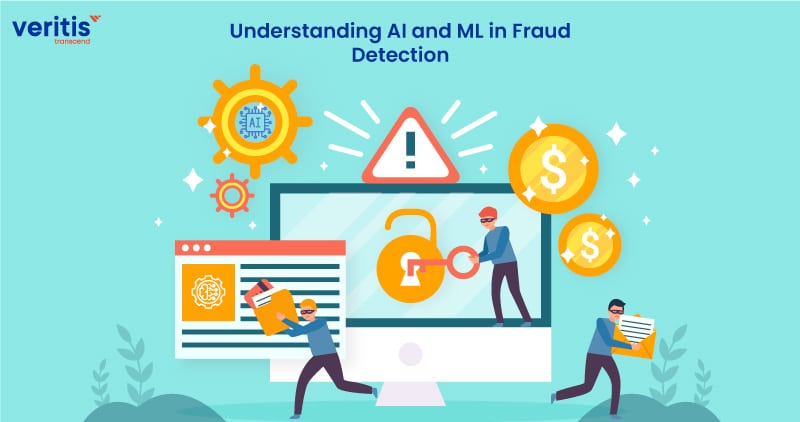
In combating retail fraud, artificial intelligence emerges as a crucial weapon, utilizing computer technologies to replicate human thought processes. This broad concept encompasses various facets, with machine learning as a prominent component. Machine learning, a fundamental component of AI, revolves around training algorithms based on provided datasets, eliminating the need for manual reprogramming. Typically, machine learning adopts one of three approaches: supervised, unsupervised, and reinforcement learning.
Deep learning, categorized within machine learning, takes automation to new heights by constructing neural networks that mimic the intricate structure of the human brain. In contrast to conventional machine learning fraud detection techniques, deep learning algorithms excel at processing unstructured data and refining their accuracy through sophisticated techniques such as backpropagation and gradient descent.
The utilization of AI in fraud detection algorithms holds significant promise in mitigating retail fraud. By leveraging historical data, AI systems can be refined to become formidable tools for detecting fraudulent activities. Given that many instances of retail fraud involve automated bots, the automated detection capabilities offered by AI and machine learning fraud detection technologies present a highly relevant and scalable solution poised to continually enhance performance and adaptability in combating evolving fraud schemes.
Artificial Intelligence Detects Common Schemes in Retail Fraud
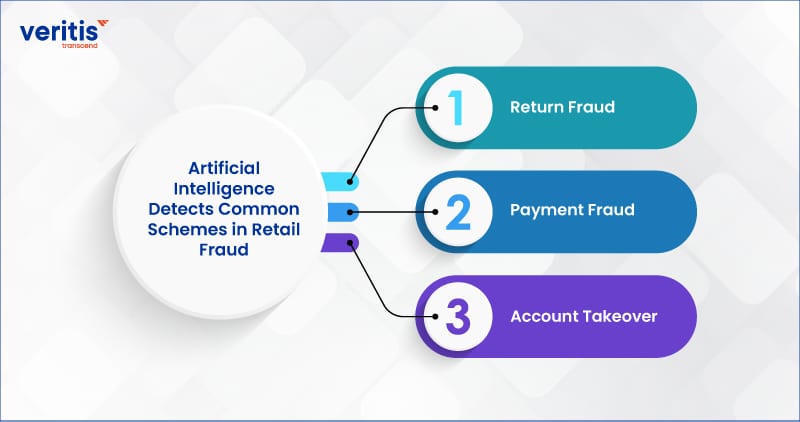
Pinpointing the exact number of fraud schemes within the retail sector is challenging due to the constant emergence of new tactics. However, three prevalent categories of fraud are associated with online retail activities.
1) Return Fraud
Exploiting return policies for illicit gains return fraud occurs when individuals exploit the leniency of return policies to obtain refunds or store credits for items they did not purchase legitimately. This may involve returning stolen goods, using counterfeit receipts, or manipulating product packaging. AI-powered fraud detection algorithms can analyze patterns in return behavior, flag suspicious activity, and help retailers mitigate losses due to fraudulent returns.
2) Payment Fraud
Unauthorized transactions and chargebacks Payment fraud in retail combines unauthorized transactions made using stolen credit card info or other payment methods. Fraudsters may employ various tactics, including card skimming, phishing, or intercepting online payment data. AI algorithms can analyze transaction patterns, detect anomalies indicative of fraudulent activity, and prevent unauthorized transactions before they occur. Additionally, AI in fraud detection algorithms can assist retailers in disputing chargebacks and recovering losses from fraudulent transactions.
3) Account Takeover
Compromising customer accounts for illicit access occurs when fraudsters gain unauthorized entry into customer accounts by stealing login credentials through phishing, credential stuffing, or social engineering attacks. Once compromised, these accounts can be used to make fraudulent purchases, redeem loyalty rewards, or access sensitive personal information. AI in retail authentication mechanisms can identify suspicious login attempts, detect unusual account activity, and implement more security measures, such as multi-factor authentication, to prevent unauthorized access and protect customer accounts.
These fraud schemes often serve as the initial stages of more elaborate criminal activities within the retail sector, including organized retail crime, inventory theft, and fraudulent refund rings. AI in fraud detection systems and prevention technologies safeguards retail businesses against financial losses and preserves consumer trust.
Useful Link: AIOps Vs MLOps: Understanding Significant Differences
Using Machine Learning for Retail Fraud Detection
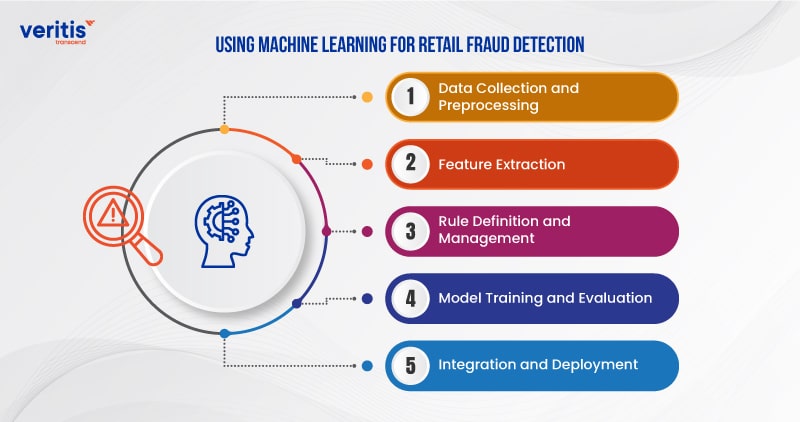
Implementing machine learning for fraud detection solutions in the retail sector follows a structured approach that can be adapted to various fraud schemes encountered by businesses. Here’s a step-by-step process tailored for retail fraud detection:
1) Data Collection and Preprocessing
Collect relevant data sources, including transaction records, customer information, product details, and historical fraud data. Preprocess the data to ensure it is structured and labeled appropriately. For supervised learning, label legitimate transactions as “good” and fraudulent activities as “bad.” Unsupervised learning techniques can also be applied to discover patterns in unstructured data.
2) Feature Extraction
Extract critical parameters from the data indicating fraudulent behavior in the retail sector. These parameters may include:
- Transaction frequency and patterns
- Transaction amounts
- Product categories and purchase history
- Customer behavior and account activity
- Geographical information such as IP addresses and shipping addresses
3) Rule Definition and Management
Analyze the extracted features to define rules that identify potential fraudulent activity. These rules range from simple thresholds (e.g., huge transactions) to complex patterns (e.g., repeated returns followed by high-value purchases). Rules may involve multiple parameters to enhance accuracy and reduce false positives. Regularly reviewing and tuning rules are essential to adapting to evolving fraud tactics.
4) Model Training and Evaluation
Train machine learning models using labeled data to identify patterns of fraudulent behavior. Evaluate the performance of the models using validation data sets and adjust parameters as needed to optimize accuracy and minimize false positives. Continuous monitoring and refinement of the models are necessary to keep pace with new fraud patterns and changing retail dynamics.
5) Integration and Deployment
Integrate the trained machine learning models into the retail organization’s fraud detection system. Ensure seamless interoperability with existing infrastructure and workflows. Provide ongoing support and maintenance to monitor model performance, address emerging fraud threats, and fine-tune algorithms as necessary.
By following this comprehensive approach, retail businesses can leverage machine learning effectively to detect and prevent fraud, safeguard operations, and maintain customer trust.
Useful Link: MLOps Best Practices: Building a Robust Machine Learning Pipeline
Advantages of Machine Learning for Retail Fraud Detection
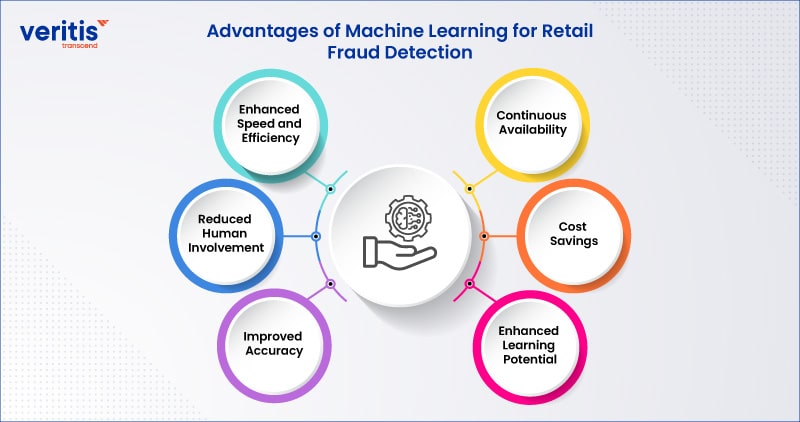
Utilizing ML fraud detection in the retail sector offers numerous benefits tailored to the industry’s specific needs:
1) Enhanced Speed and Efficiency
ML algorithms can process large amounts of retail transaction data at lightning speed, enabling real-time detection of fraudulent activities. This rapid analysis facilitates immediate responses to emerging fraud threats, helping retail businesses mitigate potential losses promptly.
2) Reduced Human Involvement
While human oversight is essential for validating AI-generated decisions, machine learning significantly reduces the manual effort required for ML fraud detection solutions. By automating transactional data analysis and flagging suspicious activities, machine learning systems alleviate the burden on retail staff, allowing them to focus on strategic tasks and customer service.
3) Improved Accuracy
Machine learning algorithms excel at identifying intricate patterns and anomalies within retail transaction data, leading to more accurate fraud detection outcomes. Continuous learning and refinement, guided by human experts, further enhance the accuracy of AML fraud detection models, minimizing false positives and ensuring precise identification of fraudulent behavior.
4) Enhanced Learning Potential
Machine learning models can continually learn and adjust to evolving fraud tactics by ingesting new retail transaction data. As data scientists feed additional information into the machine learning system, it becomes increasingly adept at recognizing emerging fraud patterns, thereby staying ahead of fraudulent activities in the dynamic retail landscape.
5) Cost Savings
Implementing machine learning for retail fraud detection systems offers significant cost savings compared to traditional manual methods. By automating repetitive tasks and streamlining the AML fraud detection solution, retailers can optimize resource allocation and reduce operational expenses associated with fraud management. Additionally, the scalability of machine learning solutions allows retailers to expand their fraud prevention and detection capabilities without incurring substantial overhead costs.
6) Continuous Availability
Unlike human analysts, machine learning systems operate around the clock without the need for breaks or downtime. While periodic maintenance and upgrades are necessary to ensure optimal performance, these tasks can be scheduled strategically to minimize disruption in AML fraud detection operations. As a result, retailers benefit from continuous vigilance against fraudulent activities, even during non-business hours.
Implementing machine learning for fraud prevention and detection in retail offers unparalleled advantages, including improved speed, accuracy, and cost-effectiveness. By harnessing the power of AI-driven analytics, retailers can fortify their defenses against fraud, safeguarding their financial assets and preserving customer trust.
Useful Link: The Rise of Artificial Intelligence and Machine Learning in Financial Decision Making Processes
ML and AI Applications in Retail Fraud Detection
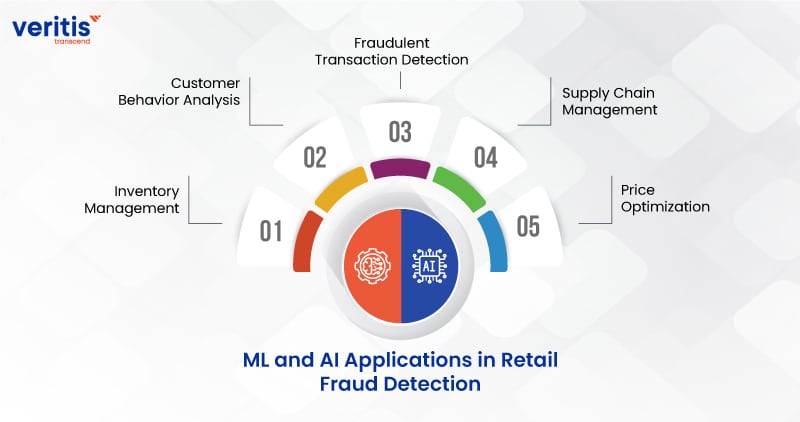
Retailers worldwide are leveraging machine learning (ML) and artificial intelligence (AI) technologies to combat fraudulent activities across various sectors of their operations:
1) Inventory Management
Retailers like Walmart utilize ML algorithms to analyze historical sales data, seasonal trends, and market demand to optimize inventory levels. By accurately forecasting demand and identifying potential stockouts or overstock situations, retailers can reduce losses due to inventory shrinkage and improve overall operational efficiency.
2) Customer Behavior Analysis
Companies like Amazon employ AI-powered recommendation systems to analyze customer browsing and purchase history. By identifying patterns in customer behavior and preferences, retailers can personalize product recommendations, enhance customer engagement, and increase sales conversion rates. Additionally, ML algorithms can detect anomalies in customer behavior that may indicate fraudulent activities, such as account takeovers or unauthorized transactions.
3) Fraudulent Transaction Detection
Retailers like eBay deploy AI-driven fraud prevention and detection systems to analyze transactional data and identify suspicious activities. ML algorithms can detect patterns indicative of fraudulent behavior, such as unusual purchase patterns, mismatched shipping addresses, or discrepancies in payment information. By flagging potentially fraudulent transactions in real-time, retailers can prevent financial losses and protect customers and their business interests.
4) Supply Chain Management
Enterprises such as Target leverage machine learning algorithms to enhance supply chain operations, minimizing risks linked to counterfeit products or disruptions within the supply chain. By analyzing data from multiple sources, such as supplier records, shipping logs, and inventory levels, retailers can detect potential vulnerabilities in the supply chain and adopt proactive measures to protect against fraud, theft, and counterfeit goods.
5) Price Optimization
Retailers like Alibaba leverage AI-powered pricing algorithms to adjust product prices based on market demand, competitor pricing, and other relevant factors. By optimizing pricing strategies in real time, retailers can maximize profitability, increase sales revenue, and mitigate the risk of price manipulation or fraudulent pricing practices.
ML and AI technologies offer retailers powerful tools for detecting and preventing fraudulent activities across their operations, from inventory management and customer behavior analysis to transaction monitoring and supply chain management. By leveraging these advanced analytics capabilities, retailers can enhance security and improve operational efficiency while delivering a seamless and secure shopping experience for their clientele.
Conclusion
As fraudsters continuously evolve their schemes, staying ahead of them requires retailers to leverage cutting-edge technologies like AI and ML in their fraud detection and prevention systems. These advanced technologies offer numerous advantages tailored to the retail sector, enabling retailers to safeguard their operations and protect their customers’ interests. Veritis, recognized for its excellence by prestigious awards such as the Stevie and Globee Business Awards, is at the forefront of implementing AI and ML solutions in the retail industry.
Despite potential drawbacks, such as the need for initial investment and ongoing maintenance, the benefits of using AI and ML for fraud detection in retail are undeniable. These technologies help retailers save confidential information, money, time, and reputation, ultimately enhancing customer trust and loyalty. By harnessing the power of AI and ML, retailers can stay ahead of fraudsters and maintain a secure and resilient retail ecosystem.
Looking for Support? Schedule A Call
Also Read:
- Impact of Information Technology on the Financial Industry
- DevOps Adoption in Financial Services Industry
- The Future of IT Financial Management: Trends and Innovations
- AI and Cybersecurity: Defending Against Evolving Threats
- AIOps Use Cases: How Artificial Intelligence is Reshaping IT Management
- Overcoming Challenges: Implementing Generative AI in Healthcare